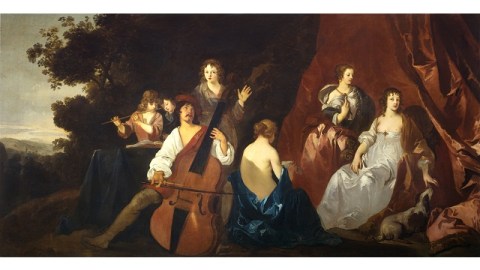Can Serious Art Be Message Free?

“A poem should not mean/ but be,” Archibald MacLeish declared in his poem “Ars Poetica.” We too-often look to the arts to explain life itself as if they function as primarily a meaning-making machine. Yes, art should give us meaning, but sometimes it exists simply to be. In that state of being art affirms the viewer’s state of being. In Peter Lely: A Lyrical Vision, which runs at The Courtauld Gallery through January 13, 2013, Peter Lely, the premier post-Anthony van Dyck portraitist of 17th century England, emerges not just as a painter of the rich and powerful, but also as a lyrical, poetic painter of fantasy and beauty for beauty’s sake. With paintings that almost seem to come with their own soundtrack, Peter Lely: A Lyrical Vision enchants with a siren song tempting us to accept that serious art doesn’t always have to come with a message.
Born in Holland in 1618, Lely arrived in England in 1641, the same year van Dyck died and left a void in the portraiture market that Lely quickly filled. Lely deftly navigated the rough waters of 17th century English politics. First court painter to Charles I, Lely became Oliver Cromwell’s post-regicide portraitist. Lely then became Charles II‘s “Principle Painter in Ordinary” after the English Restoration in 1660. Talent always seemed to win out, no matter who else lost. “O sacred Peincture! that dost fairly draw,/ What but in mists deep inward Poets saw,” Richard Lovelace wrote in Peinture, his tribute to his friend Lely. “’Twixt thee and an Intelligence no odds,/ That art of privy council to the gods!” Lely’s divine touch and sensibility allowed him to look as deeply as the poets while rising above the fortunes of kings.
What sets Peter Lely: A Lyrical Vision apart from the typical exploration of 17th century English art is its laser focus on his non-portraiture work, which is often dismissed for failing to depict the powerful or power itself. In Nymphs by a Fountain, Lelyindulged in the Arcadian theme he loved, but his portrait-infatuated patrons did not. But rather than dive into specific Arcadian literature and lore, Lely paints his non-idealized ladies with contemporary hairstyles (and contemporary clothing cast aside). These nymphs flourish comfortably in their skin with no message save an invitation to join the fun.
Similarly, Lely’s The Concert (shown above, c. 1650) indulges in message-free pleasure. As exhibition curator Dr. Caroline Campbell describes in a short video, Lely only wanted “to paint pictures of love, mythology, and music” when he first came to England and deferred that desire during his portrait-making heyday. Campbell approaches The Concert as a deceptively simple, enigmatic work. To the left are a group of musicians, who may be Lely himself (in front, looking skyward as he plays a viola de gamba) and his family. To the right is an audience of breast-baring fantasy women pointing to their elaborate jewels. There’s a disconnect between the figures as well as between the painting and viewers searching for some kind of definitive message. “I think he intended it to be an allegory,” Campbell concludes, inconclusively, “a mystery, that we would look at and enjoy looking at.” Sit back and enjoy the music, Lely asks. Just look, and be. In an age fraught with political change and changing fortunes, Lely’s call to be seems the most logical response.
Looking at The Concert reminded me of theologian Karl Barth’s take on Mozart’s music. In the collection of Barth’s writings on Mozart (whom Barth said would be the first person he’d search for in the afterlife), the theologian says of Mozart that the composer “does not wish to say anything: he just sings and sounds.” Whereas Bach earlier wrote musical religious doctrine and Beethoven later wrote confessional sturm und drang, Mozart “does not force anything on the listener,” but rather “simply leaves him free.” “Mozart’s music always sounds unburdened, effortless, light,” Barth praises Mozart. “This is why it unburdens, releases, and liberates us.” The paintings in Peter Lely: A Lyrical Vision also unburden, release, and liberate even more than 400 years after they were made. Lely died eight decades before Mozart was even born, but it’s not hard to imagine the two of them jamming together, just being with the music and one another.
[Image:Peter Lely (1618-80). The Concert, c. 1650. Oil on canvas, 123.1 x 234 cm. The Courtauld Gallery, London.]
[Many thanks to The Courtauld Gallery for providing me with the image above and other press materials related to Peter Lely: A Lyrical Vision, which runs through January 13, 2013.]





